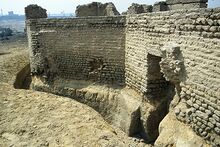643
► | قرن 6 | << قرن 7 >> | قرن 8 | ◄
► | عقد 610 | عقد 620 | عقد 630 | << عقد 640 >> | عقد 650 | عقد 660 | عقد 670 | ◄
► | ► | 638 | 639 | 640 | 641 | 642 | << 643 >> | 644 | 645 | 646 | 647 | 648 | ◄ | ◄
تحويل 1-1-643م الى هجري (وصلة خارجية) | تحويل 31-12-643م الى هجري (وصلة خارجية) | ابحث في الموسوعة عن مواضيع متعلقة بسنة 643
| الألفية: | الألفية 1 |
|---|---|
| القرون: | القرن 6 - القرن 7 - القرن 8 |
| العقود: | عقد 610 عقد 620 عقد 630 - عقد 640 - عقد 650 عقد 660 عقد 670 |
| السنوات: | 640 641 642 - 643 - 644 645 646 |
| 643 حسب الموضوع | |
| السياسة | |
| زعماء الدول – الدول ذات السيادة | |
| تصنيفات المواليد والوفيات | |
| المواليد – الوفيات | |
| تصنيفات التأسيسات والانحلالات | |
| تأسيسات – انحلالات | |
| التقويم الگريگوري | 643 DCXLIII |
| آب أوربه كونديتا | 1396 |
| التقويم الأرمني | 92 ԹՎ ՂԲ |
| التقويم الآشوري | 5393 |
| التقويم البهائي | −1201 – −1200 |
| التقويم البنغالي | 50 |
| التقويم الأمازيغي | 1593 |
| سنة العهد الإنگليزي | N/A |
| التقويم البوذي | 1187 |
| التقويم البورمي | 5 |
| التقويم البيزنطي | 6151–6152 |
| التقويم الصيني | 壬寅年 (الماء النمر) 3339 أو 3279 — إلى — 癸卯年 (الماء الأرنب) 3340 أو 3280 |
| التقويم القبطي | 359–360 |
| التقويم الديسكوردي | 1809 |
| التقويم الإثيوپي | 635–636 |
| التقويم العبري | 4403–4404 |
| التقاويم الهندوسية | |
| - ڤيكرام سامڤات | 699–700 |
| - شاكا سامڤات | 565–566 |
| - كالي يوگا | 3744–3745 |
| تقويم الهولوسين | 10643 |
| تقويم الإگبو | −357 – −356 |
| التقويم الإيراني | 21–22 |
| التقويم الهجري | 22–23 |
| التقويم الياباني | N/A |
| تقويم جوچى | N/A |
| التقويم اليوليوسي | 643 DCXLIII |
| التقويم الكوري | 2976 |
| تقويم مينگوو | 1269 قبل جمهورية الصين 民前1269年 |
| التقويم الشمسي التايلندي | 1186 |
Year 643 (DCXLIII) was a common year starting on Wednesday (link will display the full calendar) of the Julian calendar. The denomination 643 for this year has been used since the early medieval period, when the Anno Domini calendar era became the prevalent method in Europe for naming years.
أحداث
حسب المكان
الامبراطورية البيزنطية
- معركة أجنادين
- Emperor Constans II recognises Theodore Rshtuni as ruler of Armenia, after his successful campaign against the Muslims. He names him commander (nakharar) of the Armenian army.
- Maurikios names himself dux of Rome, and revolts against exarch Isaac (Exarchate of Ravenna). He declares Rome's independence from the Exarchate and from the Byzantine Empire.
أوروپا
- King Rothari of the Lombards issues the Edictum Rothari, which is the first codification of Lombard law (written in Latin). The edict guarantees rights only for Lombard subjects.
- Duke Leuthari II has Otto, mayor of the palace of Austrasia, murdered. He is succeeded by Grimoald the Elder, the eldest son of Pepin of Landen.
بريطانيا
- King Cynegils of Wessex dies after a 32-year reign, and is succeeded by his son Cenwalh (who is still pagan); he marries the sister of King Penda of Mercia (تاريخ تقريبي).
فارس
- Peroz III, son of Yazdegerd III, the last Sassanid king of Persia, flees to territory under the control of the Tang Dynasty in China (تاريخ تقريبي).
أفريقيا
- الفسطاط (the nucleus of Cairo ) is founded by the Arab general Amr ibn al-As .
- Arab–Byzantine War: Arab armies continue their military expansion into North Africa and lay siege to Tripoli. The city is captured after one month.
- 'Amr ibn al-'As sends a detachment to Sabratha (modern Libya). The city puts up feeble resistance, but soon surrenders and agrees to pay Jizya.
آسيا
- Chinese prefectural government officials travel to the capital of Chang'an, to give the annual report of the affairs in their districts. Emperor Taizong discovers that many have no proper quarters to rest in, and are renting rooms with merchants. Therefore, Taizong orders the government agencies in charge of municipal construction to build every visiting official his own private mansion in the capital.
- A Chinese embassy is sent to the North Indian Empire. They are invited by Emperor Harsha, who holds a Buddhist convocation at the capital Kannauj, which is attended by 20 kings and thousands of pilgrims.[1]
- Taizong commissions artist Yan Liben to paint in the Lingyan Pavilion the life-size portraits of 24 government officials, to commemorate their service and contributions to the founding of the Tang Dynasty.
حسب الموضوع
الدين
- Æbbe establishes a monastery at Ebchester, known as Kirk Hill at St Abb's Head near Coldingham (Scotland).
مواليد
وفيات
- April 29 – Hou Junji, chancellor of the Tang Dynasty
- September 19 – Goeric, bishop of Metz
- Cynegils, king of Wessex (تاريخ تقريبي)
- Maurikios Chartoularios, Byzantine rebel leader
- Otto, mayor of the palace (Austrasia)
- Wei Zheng, chancellor of the Tang Dynasty (و. 580)
الهامش
- ^ Watters, Thomas. "On Yuan Chwang's Travels in India". Two volumes. 1904–1905, Royal Asiatic Society, London. One volume reprint: Munshiram Manoharlal, Delhi, 1973, pp. 343–344

